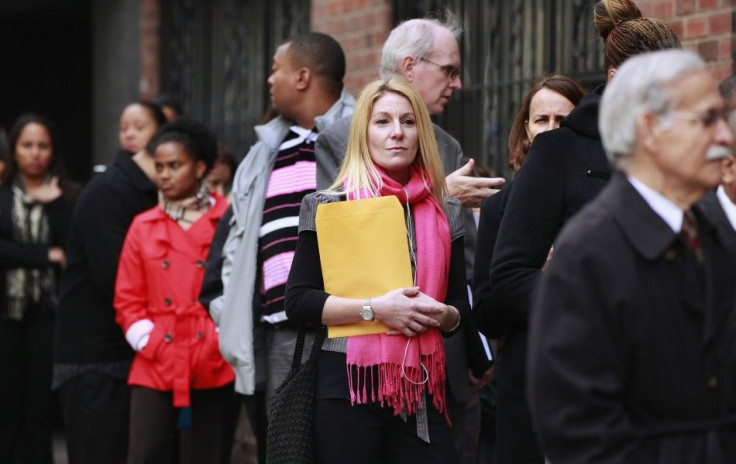US Unemployment Rate Likely To Hold At 8.3% In March

U.S. employers probably hired more than 200,000 workers for the fourth straight month in March, economists said in anticipation of the March nonfarm payroll report due Friday, pointing to another Good Friday for the labor market.
However, Federal Reserve policymakers cautioned that recent solid gains in hiring could fizzle if U.S. economic growth remains out of sync.
We are still really cautious in our employment outlook, said Kim Fraser, an economist with BBVA Compass, the trade name of Compass Bank, located in Birmingham, Ala.
We don't expect better data than the past few months, Fraser said, adding that the pace of the recent labor market improvement seems almost too good to be true.
The U.S. still has about 13 million people who are unemployed, against 142 million employed people, and 88 million who are out of the labor force, data from the Bureau of Labor Statistics showed.
Payrolls, Jobless Rate
Payrolls climbed last month by 203,000, after a 227,000 rise in February, according to the median forecast of economists surveyed by Reuters ahead of Friday's monthly Labor Department report on March hiring.
Economists also expect Friday's report to show March's unemployment rate holding at a three-year low of 8.3 percent for the third time in a consecutive month as the labor participation rate began to tick up.
In February, the labor participation rate rose slightly to 63.9 percent from 63.7 percent in the prior month, but it still remains at a relatively high level.
With economic optimism on the mend, our expectation is that the labor force participation rate is climbing, raising the threshold of jobs necessary to bring the jobless rate down, Bank of America economist Ethan Harris wrote in a recent research note to clients.
Private employment expanded by 218,000 after a 233,000 gain in February, according to the survey.
Job gains lead to income growth that supports consumer spending, which accounts for more than 70 percent of U.S. economic growth.
Many people are more confident in the economy, despite stagnant wages and rising gas prices. The University of Michigan Consumer Sentiment Survey index rose in March to 76.2, its highest level since February 2011, from 75.3 in the previous month.
According to the latest data available, Americans boosted their spending in February by the most in seven months, even as their income barely grew.
Economists aren't expecting any surprises in hours worked, which should remain steady at 34.5 or in hourly earnings, which is forecast to rise 0.2 percent.
Manufacturing Leads Recovery
Manufacturing payrolls are expected to have added 20,000 jobs in March, after increasing by 31,000 in February.
Manufacturing has remained resilient throughout this recovery, said Ellen Zentner, an economist at Nomura Securities in New York.
Indicators released ahead of Friday's payroll report have pointed to another healthy round of manufacturing jobs in March.
The ISM Manufacturing Index rose to 53.4 in March from 52.4 in February, slightly ahead of the market consensus of 53.0.
Over 80 percent of the industries surveyed reported growth, the most in nearly a year.
For the first quarter, the ISM averaged 53.3, which is consistent with roughly 3.5 percent real gross domestic growth -- another sign that the manufacturing sector continues to do better relative to the rest of the economy.
The employment index improved to 56.1, the best level since June 2011 and consistent with an ongoing improvement in manufacturing sector employment.
Meanwhile, after the construction sector posted a less-than-expected gain in February, economists are looking for some improvement in March, supported by a revival in remodeling.
Weather Payback
The economy has added an average of nearly 250,000 jobs over the past three months, and the jobless rate remained at 8.3 percent. Meanwhile, the number of people applying for initial unemployment benefits continued its descent, with the four-week moving average hitting cycle lows.
We haven't seen a string of job growth of that magnitude, and for that many consecutive months in some time, Zentner said.
Although the upcoming March employment report might still benefit from the favorable weather conditions, after an extremely warm winter helped boost job gains, some economists have become concerned that the so-called weather payback will become a rising headwind in the spring.
March also was a record-setting month in terms of favorable weather, Zentner said. So we don't think weather is going to pose much of a headwind in March.
However, due to the warmer-than-expected weather, people might have been more involved in job searching earlier in the year, rather than doing it later.
Seasonal factors will subtract about 1.5 million jobs over April and May, wrote Ted Wieseman, an economist at Morgan Stanley, in a note.
FOMC
The Fed is concerned that the recovery could falter, as it did last year.
In its March 13 Federal Open Market Committee meeting, a number of policymakers said while recent employment data had been encouraging there was a non-negligible risk that improvements in employment could diminish as the year progressed.
The minutes of that meeting, which were released Tuesday, echoed a speech Fed Chairman Ben Bernanke delivered last week to a gathering of economists.
Bernanke said the rapid declines in the unemployment rate seem to be out of sync with the overall pace of economic expansion and is something of a puzzle.
U.S. gross domestic product grew 3 percent in the last three months of 2011, but it is expected to have slowed to just below 2 percent in the first quarter of 2012. For all of last year, it expanded only 1.7 percent.
Normally, it takes roughly 4 percent annual growth to lower the rate by 1 percentage point over a year.
Bernanke cautioned that he doesn't expect the unemployment rate to keep falling at its current pace without much stronger growth and more robust hiring
The minutes didn't show much enthusiasm among Fed officials for launching another round of quantitative easing, or QE3, any time soon.
© Copyright IBTimes 2024. All rights reserved.





















